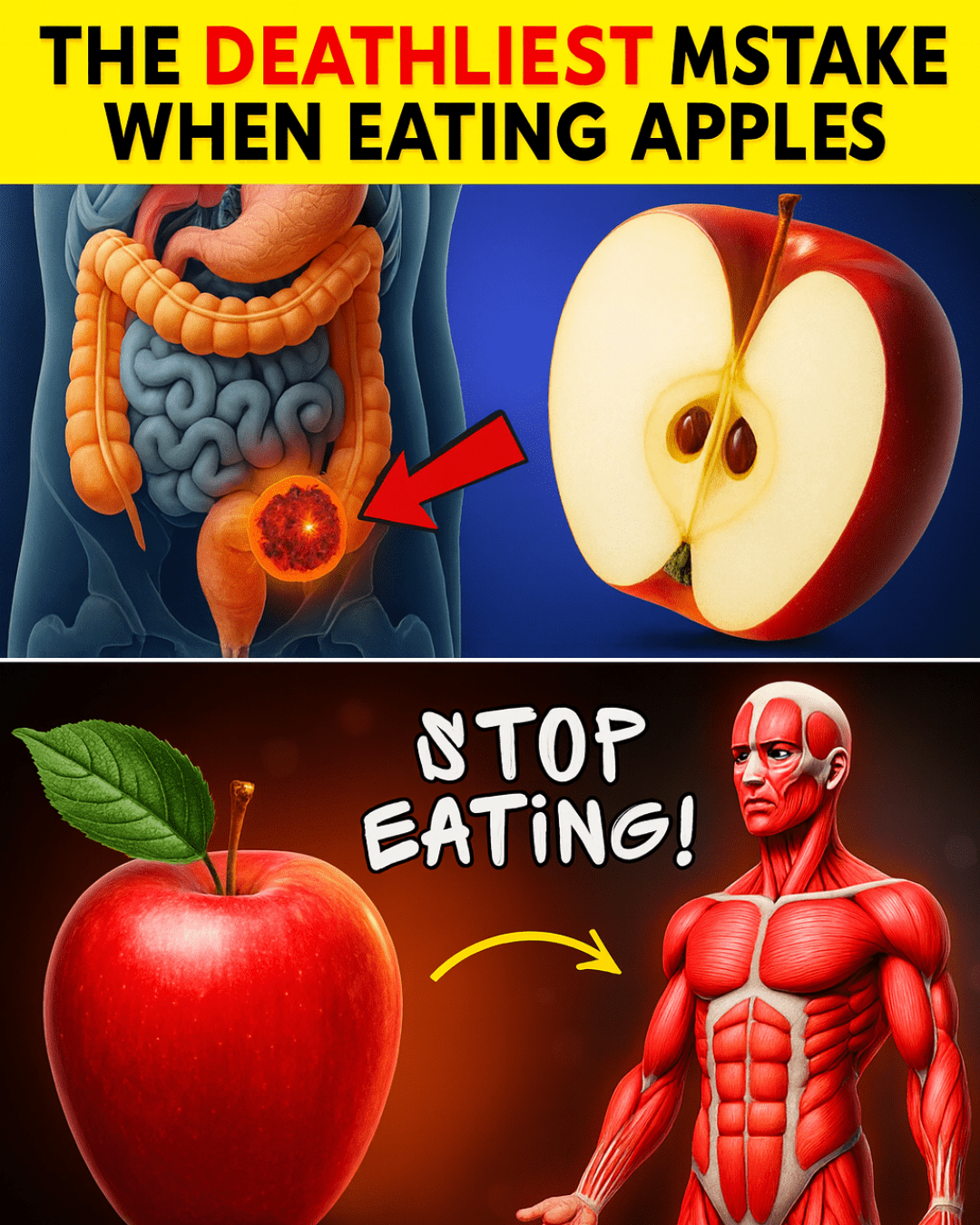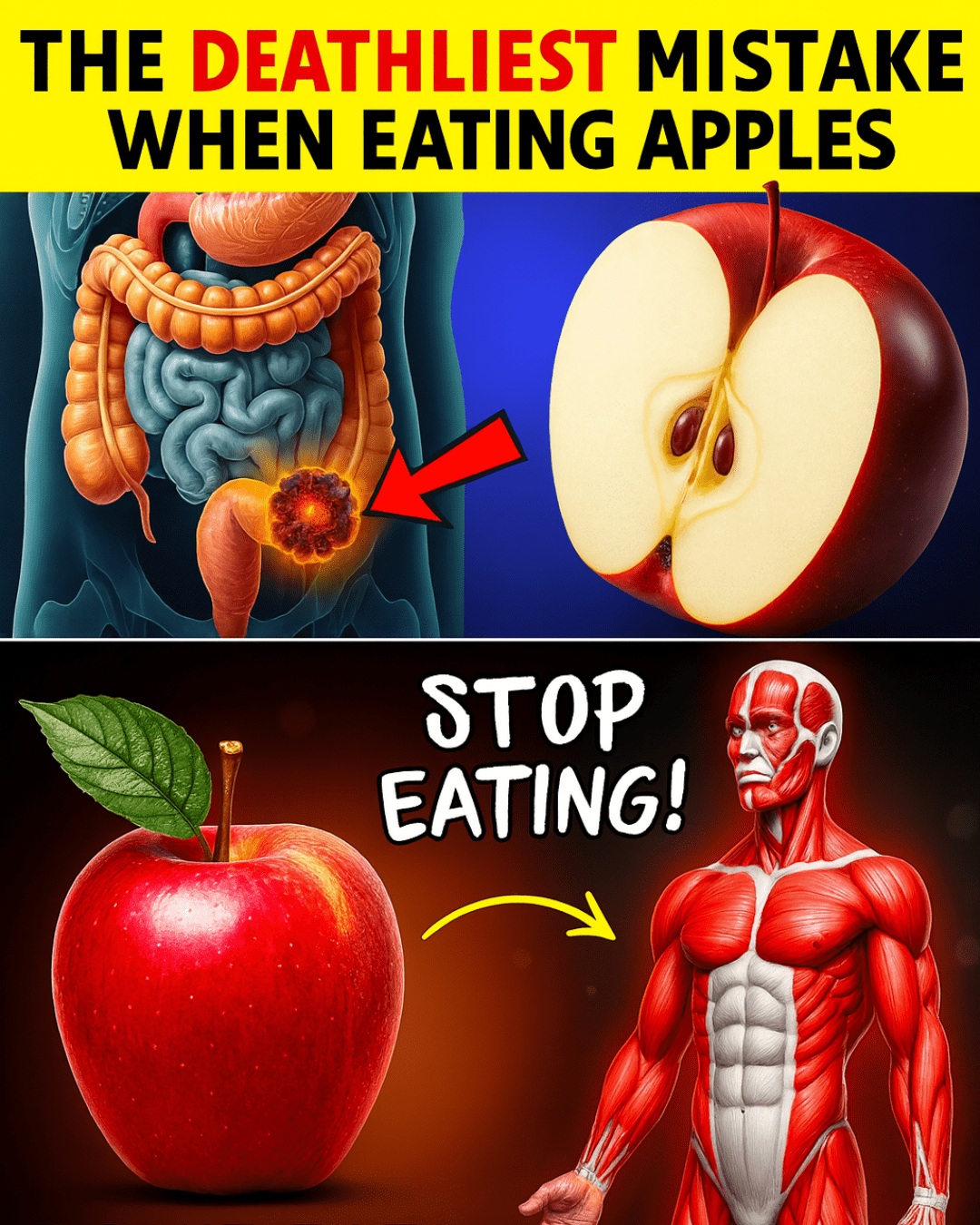🤯 The Unseen Dangers: Are You Turning a Superfood Into a Health Risk?
The saying goes, “An apple a day keeps the doctor away.” The apple (Malus domestica) is the quintessential symbol of health—crisp, satisfying, and packed with fiber, vitamins, and powerful antioxidants like quercetin. It is one of nature’s most perfect snacks.

Yet, despite their legendary status, most people unknowingly make eight critical mistakes when consuming apples. These common errors aren’t just minor missteps; they can drastically reduce the nutritional benefit of the fruit, expose you to hidden toxins, worsen digestive issues, or even cause dental damage.
Are you sabotaging your health with a bad habit you’ve been doing since childhood? Stop compromising your well-being! We’ve uncovered the science behind these common pitfalls and provided simple, expert-backed fixes. Read on to discover the 8 mistakes you must avoid to truly unlock the full, transformative power of this everyday superfood.
🚩 Mistake #1: Skipping the Peel (The Fiber Fiasco)
This is the most common mistake and the biggest nutritional blunder. Many peel apples out of habit or preference, completely missing the fruit’s most valuable resource.
- The Science: The peel is a concentrated source of two critical components: insoluble fiber and quercetin. The peel contains up to two-thirds of the apple’s total fiber and the vast majority of its antioxidants. Quercetin, a potent flavonoid, is essential for its anti-inflammatory and potential allergy-fighting effects.
- The Fix: Always eat the peel. If texture is an issue, try slicing the apple very thinly or baking it (which softens the peel) to still get the maximum nutritional benefit.
🦷 Mistake #2: Biting Directly into a Whole Apple (The Dental Hazard)
While the crispness of an apple is part of its charm, biting directly into the whole fruit can be surprisingly damaging to your dental health.
- The Science: The sheer force required to bite and tear a whole, firm apple can put dangerous stress on your front teeth. This risk is particularly high if you have veneers, crowns, sensitive gums, or weakened tooth enamel. Furthermore, apples are highly acidic, and grinding them down can bathe your teeth in acid.
- The Fix: Slice the apple first. This allows you to chew with your molars, which are designed to handle grinding forces. After eating, rinse your mouth with water immediately to neutralize the acid and protect your enamel.
🧪 Mistake #3: Ignoring the Wax Coating and Pesticides (The Toxin Trap)
Commercially grown apples are often treated with pesticides and, after harvest, coated with a thin layer of edible wax to enhance shelf life and appearance.
- The Science: Although the wax itself is safe, it traps pesticide residues beneath its surface. Even non-organic apples labeled “washed” still carry residue. Consuming these residues can negate the detoxifying benefits of the apple.
- The Fix: Wash thoroughly. Whether organic or conventional, always clean your apples using a gentle fruit and vegetable wash or by soaking them in a mixture of water and baking soda for 12–15 minutes, followed by a vigorous rinse. Better yet, choose organic when possible.
🍎 Mistake #4: Eating Apples Immediately After a Large Meal (The Digestive Drag)

Eating fruit immediately after a heavy meal is a habit many have adopted, but it can lead to uncomfortable digestive side effects.
- The Science: Fruits, especially those high in simple sugars and fiber like apples, are digested rapidly. When eaten immediately after a large meal (protein, fat, complex carbs), the apple gets “stuck” in the stomach behind the slower-digesting food. This can lead to the fruit fermenting, causing gas, bloating, and discomfort.
- The Fix: Mind the Gap. Wait at least 30 minutes before or 2 hours after a substantial meal to enjoy your apple. This allows the stomach to clear the heavier contents, optimizing the apple’s rapid digestion.
🥜 Mistake #5: Eating Apples Completely Alone (The Blood Sugar Spike)
While an apple is a great snack, eating it in isolation can lead to energy crashes and rapid hunger.
- The Science: Although apples have fiber, the natural sugars (fructose) are released quickly. Without a mitigating factor, this can cause a modest blood sugar spike followed by a crash, particularly for sensitive individuals.
- The Fix: Pair it with Protein or Fat. Always consume your apple with a source of healthy fat or protein, such as a tablespoon of almond butter, a small handful of walnuts, or a piece of cheese. This slows down sugar absorption, provides steady energy, and maximizes satiety.
💨 Mistake #6: Consuming Too Many Apples in One Sitting (The Fiber Overload)
“If one is good, ten must be better” does not apply to apples or most high-fiber foods.
- The Science: Apples are primarily high in pectin, a type of soluble fiber. While fantastic for the gut, consuming a huge quantity (3+ apples) in a short period can suddenly introduce too much fiber, leading to excessive gas, severe bloating, abdominal pain, and even diarrhea.
- The Fix: Moderate Your Intake. Stick to 1 to 2 medium apples per day, spread out across your meals or snacks. Ensure you drink plenty of water to help the soluble fiber move smoothly through your digestive system.
🥶 Mistake #7: Relying Exclusively on Apple Juice (The Nutrient Loss)
Juicing apples is a popular choice, but it often sacrifices the fruit’s most valuable health components.
- The Science: Juicing removes virtually all of the fiber and much of the skin’s beneficial antioxidants. What remains is essentially concentrated sugar water. Without the fiber, the juice causes a much more rapid and significant blood sugar spike than eating the whole fruit, negating the primary health benefits of the apple.
- The Fix: Eat the Whole Fruit. If you choose to juice, ensure the juice is consumed alongside a meal containing fiber or fat to slow absorption, or better yet, make a smoothie where the whole apple (including the peel) is blended, preserving all the fiber.
🚯 Mistake #8: Discarding the Core and Seeds (The Potential Toxin)
While most people correctly discard the core, understanding why is essential for safety, even if the risk is small.
- The Science: Apple seeds contain a compound called amygdalin, which can release trace amounts of cyanide when digested. While accidentally swallowing a few seeds is harmless (they pass undigested), chewing and consuming a large quantity of crushed or broken seeds is ill-advised.
- The Fix: Simply discard the core and seeds. While the toxicity is minimal and requires consuming hundreds of seeds to be truly dangerous, there is zero nutritional benefit to consuming the core or seeds, so play it safe and stick to the flesh.
🌟 The Final Word: Maximize Your Daily Apple
The apple is a fantastic tool for boosting your fiber, antioxidant intake, and overall wellness. But like any powerful tool, it must be used correctly. By avoiding these 8 common mistakes, you can move from passively eating an apple to actively optimizing your health with every crisp bite.
Stop making these critical errors today and truly let that apple keep the doctor away.
Deep Research
Video
🍌 Hình ảnh
Canvas






